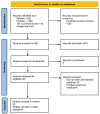Association between HbA1c Levels and Fetal Macrosomia and Large for Gestational Age Babies in Women with Gestational Diabetes Mellitus: A Systematic Review and Meta-Analysis of 17,711 Women
- PMID: 37298047
- PMCID: PMC10253627
- DOI: 10.3390/jcm12113852
Association between HbA1c Levels and Fetal Macrosomia and Large for Gestational Age Babies in Women with Gestational Diabetes Mellitus: A Systematic Review and Meta-Analysis of 17,711 Women
Abstract
Gestational diabetes mellitus (GDM) is the most common metabolic disorder in pregnancy. GDM is associated with serious maternal and fetal complications, in particular, fetal macrosomia and large for gestational age (LGA), which predisposes to a higher risk of childhood obesity and type 2 diabetes mellitus later in life. Early prediction and diagnosis of GDM leads to early interventions such as diet and lifestyle, which could mitigate the maternal and fetal complications associated with GDM. Glycated haemoglobin A1c (HbA1c) has been widely used for monitoring, screening for and diagnosing diabetes and prediabetes. Increasing evidence has also showed that HbA1c could indicate fetal glucose supply. Thus, we hypothesise that the HbA1c level at around 24 to 28 weeks may predict the development of fetal macrosomia or an LGA baby in women with GDM, which could be useful for better prevention of fetal macrosomia and LGA. We searched MEDLINE, EMBASE, Cochrane and Google Scholar databases from inception to November 2022 for relevant studies that reported at least one HbA1c level during 24-28 weeks of pregnancy and fetal macrosomia or an LGA baby. We excluded studies that were not published in the English language. No other search filters were applied during the search. Two independent reviewers selected eligible studies for meta-analysis. Two independent reviewers performed data collection and analyses. The PROSPERO registration number is CRD42018086175. A total of 23 studies were included in this systematic review. Of these, 8 papers reported data of 17,711 women with GDM that allowed for inclusion in a meta-analysis. The obtained results demonstrated the prevalence of fetal macrosomia was 7.4% and of LGA, 13.36%. Meta-analyses showed that the estimated pooled risk ratio (RR) for LGA in women with high HbA1c values compared to normal or low values was 1.70 (95% CI: 1.23-2.35), p = 0.001; and the pooled RR for fetal macrosomia was 1.45 (95% CI: 0.80 to 2.63), p = 0.215. Further research is needed to evaluate the utility of HbA1c levels in predicting the delivery of a baby with fetal macrosomia or LGA in pregnant women.
Keywords: GDM; HbA1c; LGA; fetal macrosomia; gestational diabetes mellitus; glycated haemoglobin; large for gestational age.
Conflict of interest statement
The authors declare no conflict of interest.
Figures





Similar articles
-
Screening and diagnosing gestational diabetes mellitus.Evid Rep Technol Assess (Full Rep). 2012 Oct;(210):1-327. Evid Rep Technol Assess (Full Rep). 2012. PMID: 24423035 Free PMC article. Review.
-
Fetal biometry for guiding the medical management of women with gestational diabetes mellitus for improving maternal and perinatal health.Cochrane Database Syst Rev. 2019 Sep 3;9(9):CD012544. doi: 10.1002/14651858.CD012544.pub2. Cochrane Database Syst Rev. 2019. PMID: 31476798 Free PMC article.
-
Metabolic syndrome in childhood: association with birth weight, maternal obesity, and gestational diabetes mellitus.Pediatrics. 2005 Mar;115(3):e290-6. doi: 10.1542/peds.2004-1808. Pediatrics. 2005. PMID: 15741354
-
The association of gestational diabetes mellitus with fetal birth weight.J Diabetes Complications. 2018 Jul;32(7):635-642. doi: 10.1016/j.jdiacomp.2018.04.008. Epub 2018 Apr 25. J Diabetes Complications. 2018. PMID: 29907325
-
Intergenerational transmission of macrosomia in women with gestational diabetes and normal glucose tolerance.Eur J Obstet Gynecol Reprod Biol. 2015 Dec;195:113-116. doi: 10.1016/j.ejogrb.2015.10.002. Epub 2015 Oct 20. Eur J Obstet Gynecol Reprod Biol. 2015. PMID: 26512436
Cited by
-
Influence of Physical Activity during Pregnancy on Birth Weight: Systematic Review and Meta-Analysis of Randomized Controlled Trials.J Clin Med. 2023 Aug 21;12(16):5421. doi: 10.3390/jcm12165421. J Clin Med. 2023. PMID: 37629463 Free PMC article. Review.
-
Maternal glycemic profiles during pregnancy and predelivery correlate with neonatal glucose homeostasis and jaundice risk: a prospective cohort study.Transl Pediatr. 2024 Nov 30;13(11):2012-2025. doi: 10.21037/tp-24-356. Epub 2024 Nov 26. Transl Pediatr. 2024. PMID: 39649657 Free PMC article.
-
Management of Endocrinopathies During Pregnancy: A Systematic Review.Cureus. 2024 Sep 30;16(9):e70554. doi: 10.7759/cureus.70554. eCollection 2024 Sep. Cureus. 2024. PMID: 39479091 Free PMC article. Review.
-
Preexisting Diabetes and Pregnancy: An Endocrine Society and European Society of Endocrinology Joint Clinical Practice Guideline.J Clin Endocrinol Metab. 2025 Aug 7;110(9):2405-2452. doi: 10.1210/clinem/dgaf288. J Clin Endocrinol Metab. 2025. PMID: 40652453 Free PMC article.
-
Maternal and fetal outcomes in gestational diabetes mellitus: a narrative review of dietary interventions.Front Glob Womens Health. 2025 Feb 26;6:1510260. doi: 10.3389/fgwh.2025.1510260. eCollection 2025. Front Glob Womens Health. 2025. PMID: 40078500 Free PMC article. Review.
References
Grants and funding
LinkOut - more resources
Full Text Sources

